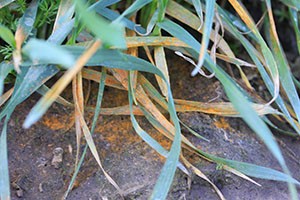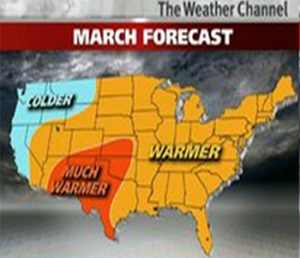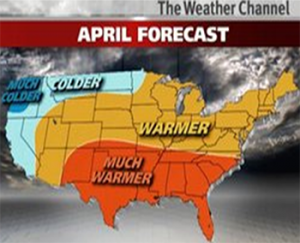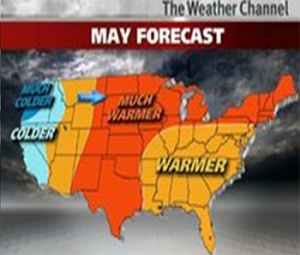Stripe Rust Forecast and Update
Xianming Chen
Field survey in Washington
On March 7, we were checking wheat fields in Whitman, Columbia, Walla Walla, Benton, Franklin, and Adams counties in eastern Washington. Winter wheat plants ranged from two-leaf stage to early jointing (Feekes 1-5), depending upon planting time and region. In most wheat fields, plants were still in winter dormancy except in the Walla Walla area, plants in many fields started growing. No matter how big plants, most fields had a very uniform crop. There was no obvious winter injury, but damage by wireworms and/or crown rot was found in a couple of early planted winter wheat fields with up to 5% incidence in the Horse Heaven Hills area.
Stripe rust was found on susceptible wheat varieties in our experimental field planted in October 10, 2012 near Walla Walla. Although the incidence is less than 1%, we were able to find more than 20 sporulating (producing spores) leaves in the small nursery field and one plant had more than 10 sporulating leaves (Fig. 1). No rust was found in any of the commercial fields in all areas, except that we were managed to find two leaves with stripe rust pustules in an early planted field along Highway 26 in Adams County. According to Stephen Reinertsen, McGregor people found stripe rust in some fields in the Horse Heaven Hill area this week. Although over-wintered stripe rust was found in commercial fields, the level of stripe rust is higher than that of 2012, but not to the high and widespread level of 2011 at this time of year.
Fig. 1. Stripe rust in a susceptible spread row in an experimental nursery found on March 7, 2013 near Walla Walla, Washington.
For western Washington, stripe rust is expected to be actively developing on susceptible wheat varieties as always, although we have not started our field activities in the Mt. Vernon area yet.
Prediction and management suggestions for the PNW
Using a series of forecast models (Sharma-Poudyal and Chen, Phytopathology 101:544-554, 2011) based on various weather parameters from November, 2012 to February, 2013 at Pullman, Washington, the new prediction of potential yield loss caused by stripe rust on susceptible winter wheat varieties is 44.0±3.5%, increased from the 40.8% forecasted based on only the December temperature and higher than the forecast (35±5%) made for 2012. This level is within a severe epidemic category (40-60% yield loss on susceptible varieties) for the region. The prediction is based on historical yield loss and weather data of the Palouse region and is applicable for most wheat growing regions in the Pacific Northwest (PNW), except western Washington, western Oregon, and southern Idaho as these regions have quite different weather patterns.
Please keep in mind that the current prediction can be realized only if the weather conditions from now throughout the remaining growing season are normal (past long-term averages). If May and June are unusually cool and wet, just like in 2010 and 2011, stripe rust would be severer than the current prediction. On the other hand, if the weather conditions from April to June are drier and from May to June hotter than normal, stripe rust would be lower than the current prediction. Unfortunately, based on the national weather forecasts, the weather for the PNW from March to May will likely be “cooler than normal” (Fig. 2). Cooler weather usually also indicates higher moisture that is more favorable for stripe rust infection. Cooler weather conditions in March and early April may result in a slow development of stripe rust, but cooler weather conditions in late April and May is more favorable for stripe rust development. Nevertheless, based on the current prediction and field observations, stripe rust will definitely not be as severe as 2011, but still have possibilities to be as severe as in 2010, and will likely be more severe than that in 2012. With the severe, but not extreme severe, level of damage potential and current observations of rust, susceptible, moderately susceptible, and possibly moderate resistant varieties may need to be sprayed with fungicides, while resistant varieties do not need spray. We expected basically similar races which occurred last year will occur in 2013, therefore, varieties resistant last year should be resistant this year. For stripe rust reactions of wheat varieties, please referred to the data sent previously and also referred to our stripe rust website (https://striperust.wsu.edu), which contains rust updates and also basic information about various aspects of the disease. Application of fungicides may be necessary at the time of herbicide application. Checking fields should be started in eastern Oregon and southern-central Washington (such as the Walla Walla, Horse Heaven Hills, and Connell areas) and from middle April in areas further north and east in Washington and Idaho. Generally, fungicides should be applied when 1-5% of rust incidence (no. of plants) or severity (percentage of sporulating leaf areas) is observed in a field. A second application may be necessary 3-4 weeks after the first application, depending upon the type and level of resistance, late rust situation, and weather conditions. Purposely delaying the first application (but not after 10% rust) may provide maximum control for more important late growth stage and may make the second application unnecessary.
Growers should choose resistant or moderately resistant spring wheat varieties to plant and avoid susceptible or moderately susceptible variety, unless you consider other factors to choose varieties, and prepare for fungicide application if needed.
In western Washington, stripe rust should be visible as always in this time of the year. Application of fungicides together with herbicides in fields grown with susceptible and moderately susceptible varieties
should be a standard procedure for maximizing profit every year in western Washington and western Oregon.
Current stripe rust situations and perspective in other regions
In south-central states, stripe rust has been developing since last December. Stripe rust was observed in Arkansas as early as on December 27, 2012, and continually reported on January 9, 2013. The disease was reported in Texas on February 7 and in Louisiana and Mississippi in the week of February 18. In these states, stripe rust has become widespread. The pathogen has possibly spread beyond these states, more likely to the northeastern direction and also possibly northward based the storm patterns since February. The recent cold weather may have slowed stripe rust development, but the disease will develop and spread quickly as the weather warms up and recent storms have provided good moisture. The disease is expected to spread to the central and northern part of the Great Plains and eastern states. A severe and widespread epidemic similar to or even worse than that of last year is possible, depending upon the weather conditions (how quickly to get hot and dry) from now. According to the national weather forecast (Fig. 2), much of the country will like to have a “warmer” or “much warmer” weather conditions from March to May. A warmer weather condition in March for most regions will likely make stripe rust develop faster. However, a warm or much warm weather condition will slow down or stop stripe rust development. Growers should look their local weather forecasts from now, as well as crop stage, variety resistance, yield potential, and how far from the regions where stripe rust had been developing, to make decisions for fungicide application.
Fig. 2. Weather conditions forecasted for March, April, and May
http://www.weather.com/video/forecast-for-the-next-3-months-33830, January 21, 2013;
http://www.weather.com/weather/tenday/Pullman+WA+99163:4:US, February 27, 2013;
http://www.weather.com/video/forecast-for-the-spring-35065, March 2, 2013



